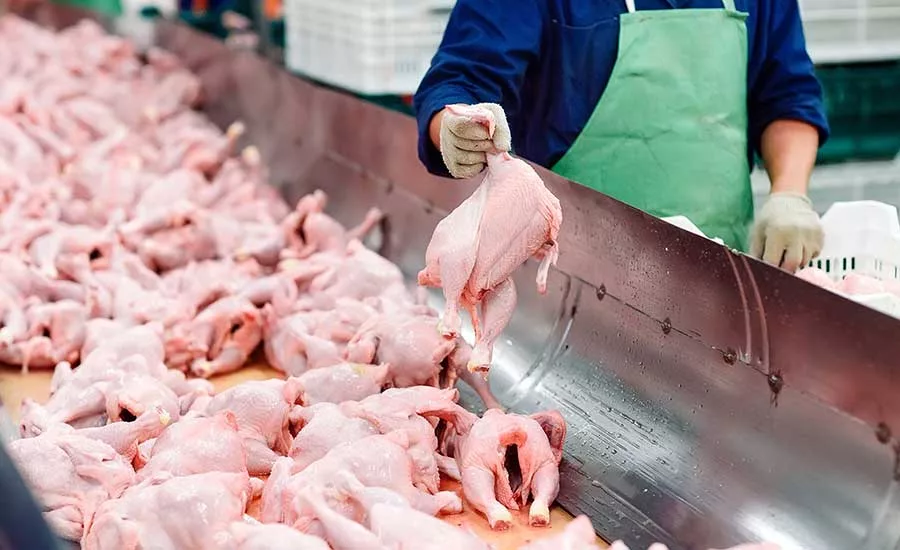Regulatory Changes Impacting Your Food Safety Program, Part 2—What Should USDA's Priorities Be?
Your opinions on USDA's proposed Salmonella regulations and your priorities for your food safety programs in 2025.

Image credit: davit85/iStock/Getty Images Plus via Getty Images
Welcome to Part 2 of our report on what we heard during our survey conducted late last year of approximately 150 food processors from 35 countries. We wanted to hear your opinions on the changing food safety regulatory landscape, including what we reported in Part 1 about the establishment of the U.S. Food and Drug Administration's (FDA's) Human Foods Program.1
In Part 2, we continue that report with more opinions on the changes coming from the U.S. Department of Agriculture (USDA) and its stance on regulating Salmonella as an adulterant in various raw poultry products. We will also discuss your priorities for your food safety programs and the key areas that you will be focusing on in 2025.
Your Thoughts on USDA's Revised Salmonella Framework
In August of 2024, USDA announced proposed regulations for comminuted chicken and turkey that declares these products adulterated if samples show Salmonella levels higher than 10 cfu/g and/or the presence of specific serotypes for chickena and turkey.b,c We wanted to hear your opinions on this proposed regulation. Will it be effective in reducing Salmonella illnesses—or does it go too far?
As can be seen in Figure 1, what we heard was a mix of different opinions, but with close to half of the respondents indicating that they believe the regulation will be successful in reducing Salmonella illnesses. That does not mean the proposal is without controversy or skepticism, however.
One processor in favor of the changes stated, "I think this makes total sense. This will hold companies to a standard of cleanliness already achieved by beef and pork." Another mentioned, "This is long overdue. This move is best for public health," with yet another agreeing by saying, "I think this is a positive step, [as] Salmonella illnesses continue to grow and these illnesses are very serious." A laboratory manager in Central America added, "It will effectively reduce Salmonella illnesses by forcing producers to improve their facilities and quality control systems."
As mentioned, however, there was a fair amount of skepticism uncovered in the survey. One processor highlighted the issues of testing when they mentioned, "I don't think it goes too far, but I am doubtful as to how much it will change things. The devil is in the details of the testing—and the rising dangers of the emergence of other serotypes."
Another processor highlighted the link between analytical test levels and root cause, commenting, "Having a report showing high levels of Salmonella is not the root cause. The focus should be placed on food safety standards and practices to prevent the presence of Salmonella."
Looking for quick answers on food safety topics?
Try Ask FSM, our new smart AI search tool.
Ask FSM →
Others also mentioned the unintended consequences of shortages and higher prices, with one saying, "These are very aggressive limits. I'm afraid this will create more food waste on the already tight supplies." Another indicated that more attention should be paid to consumer behavior as a more effective preventive measure when they commented, "It goes too far. It will cause more food waste. Industry needs to do a better job of convincing the final user to practice food safety as much as industry does. Too many times, individuals are careless in their own kitchens, but expect perfection from industry."
A processor in the UK countered this opinion, stating that the regulations may not go far enough and making the point, "Ten cfu/g is too high a limit. In people with compromised immune systems, the elderly, and the very young, ten cfu/g is enough to cause a food poisoning incident. In the UK and the EU, the very presence of Salmonella is notifiable."
What You Would Like to Ask FSIS Leadership
It is clear that, should these regulations be implemented as proposed, there will be an impact on industry. Many will be keeping a close eye on the results. It is also clear that these new Salmonella regulations, as well as many other issues, may have USDA under the proverbial microscope. So, as we challenged our survey respondents in Part 1 to offer their questions for FDA's Deputy Commissioner for Human Foods Jim Jones, we also asked "If you could ask any question or make a request to the USDA Deputy Under Secretary for Food Safetyd, what would that be?"
A summary of the most common questions is presented in Table 1. Many of the questions were related to specific issues, especially the Boar's Head Listeria outbreak and recall and the proposed Salmonella regulations. There was also a clear thread on questions about how the agency can be more effective, how industry can be more effective, and how the two working together can not only be more effective but also demonstrate that effectiveness to win back consumer trust. It is also clear that industry is looking for USDA to lead this cooperation, especially through better communication from USDA-FSIS inspectors. Better resources for education and training were also mentioned.
This drive for a better relationship and more input from regulators was also reflected in the responses to one of our other questions when we asked, "What do you wish regulators understood better?" As shown in Figure 2, the most common answers were related to their interactions with regulators onsite, the regulators' ability to understand the practical challenges that processors face, and the need for regulators to better understand what happens on the plant floor.
As one processor commented, "I'm not sure how many of them have actually worked in a food processing facility; it seems like a lot of them are book trained. Maybe a year of actual work in a food processing facility would be helpful." Others mentioned that some regulations can have significant impacts on their operations, and many companies (especially smaller ones) may need more help, time, and understanding from their regulatory partners and inspectors. They ask that regulators understand that food processors are doing their best with limited resources. They are also looking to the inspectors and to USDA in general for more education and training vs. moving directly to enforcement actions.
Top Priorities for Your Food Safety Programs
Regardless of how relationships with regulatory partners develop, continuous improvement of food safety programs remains the order of the day for 2025. This is clear in the responses we heard to our question, "What are the top priorities for your food safety program in 2025?"
What we heard (Figure 3) should be no surprise to any readers of this column or Food Safety Magazine. In general, responses overall can be characterized as an ongoing and continuous focus on food safety fundamentals. This can be seen in the most common goal—with close to three times the number of the next highest response—of making improvements in sanitation and environmental monitoring programs in order to maintain and/or improve pathogen control. We have reported on this topic many times in this column, and it is good to see that food safety professionals continue to strive for the very best in sanitation and pathogen control. The next two most common answers—food safety culture and issues related to traceability—should also be familiar. Compliance with FSMA 204 was often mentioned, and supply chain control remains a high priority.
We will continue to follow developments both in the FDA's Human Foods Program and with USDA's proposed Salmonella regulations, as well as many other topical issues that are on your mind, in future columns. Keep an eye on Food Safety Insights for those details!
References
- Ferguson, B. "Regulatory Changes Impacting Your Food Safety Program, Part 1—What Should FDA's Priorities Be?" Food Safety Magazine December 2024/January 2025. https://www.food-safety.com/articles/10019-regulatory-changes-impacting-your-food-safety-program-part-1what-should-fdas-priorities-be.
Notes
a For chicken, the serotypes are Salmonella Enteritidis, S. Typhimurium and S. 4,[5],12:i.
b For turkey, the serotypes are Salmonella Hadar, S. Typhimurium, and S. Muenchen.
c These were the terms of the proposal at the time of our survey and the writing of this article. The comment period for the proposal was scheduled to end on January 17, 2025, and changes to these terms and the proposed regulation may be in process.
d In the survey, we specifically asked the question, "If you could ask any question or make a request to USDA Deputy Under Secretary for Food Safety Sandra Eskin, what would that be?" Since the time of our survey, Sandra Eskin has left her position at USDA and, as of this writing, a successor has not yet been named.
Bob Ferguson is President of Strategic Consulting Inc. and can be reached at bobferguson9806@gmail.com or on X/Twitter at @SCI_Ferguson.








